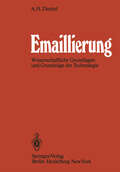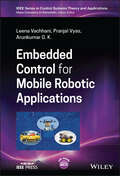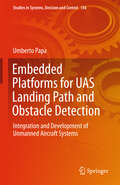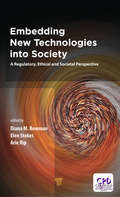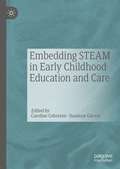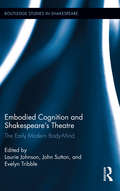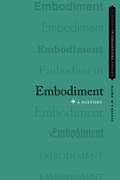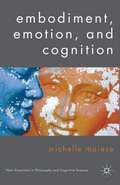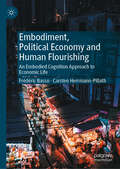- Table View
- List View
EMATs for Science and Industry: Noncontacting Ultrasonic Measurements
by Masahiko Hirao Hirotsugu OgiEMATs for Science and Industry comprises the physical principles of electromagnetic acoustic transducers (EMATs) and the applications to scientific and industrial ultrasonic measurements on materials. The text is arranged in four parts: -PART I is intended to be a self-contained description of the basic elements of coupling mechanism along with practical designing of EMATs for various purposes. There are several implementations to compensate for the low transfer efficiency of the EMATs. Useful tips to make an EMAT are also presented. -PART II describes the principle of electromagnetic acoustic resonance (EMAR), which makes the most of contactless nature of EMATs and is the most successful amplification mechanism for precise velocity and attenuation measurements. -PART III applies EMAR to studying the physical acoustics. New measurements emerged on three major subjects; in situ monitoring of dislocation behavior, determination of anisotropic elastic constants, and acoustic nonlinearity evolution. -PART IV deals with a variety of individual topics encountered in industrial applications, for which the EMATs are believed to the best solutions.
EMBEC & NBC 2017: Joint Conference of the European Medical and Biological Engineering Conference (EMBEC) and the Nordic-Baltic Conference on Biomedical Engineering and Medical Physics (NBC), Tampere, Finland, June 2017 (IFMBE Proceedings #65)
by Hannu Eskola Outi Väisänen Jari Viik Jari HyttinenThis volume presents the proceedings of the joint conference of the European Medical and Biological Engineering Conference (EMBEC) and the Nordic-Baltic Conference on Biomedical Engineering and Medical Physics (NBC), held in Tampere, Finland, in June 2017. The proceedings present all traditional biomedical engineering areas, but also highlight new emerging fields, such as tissue engineering, bioinformatics, biosensing, neurotechnology, additive manufacturing technologies for medicine and biology, and bioimaging, to name a few. Moreover, it emphasizes the role of education, translational research, and commercialization.
Embedded Control for Mobile Robotic Applications (IEEE Press Series on Control Systems Theory and Applications)
by Leena Vachhani Pranjal Vyas Arunkumar G. K.An all-in-one resource for designing and implementing embedded control in mobile robotics In Embedded Control for Mobile Robotic Applications, a distinguished trio of researchers delivers an authoritative and fulsome resource for understanding embedded control and robotics. The book includes coverage of a variety of embedded platforms, their use in controller implementation, stability analyses of designed controllers, and two new approaches for designing embedded controllers. The authors offer a full chapter on Field-Programmable-Gate-Array (FPGA) architecture development for controller design that is perfect for both practitioners and students taking robotics courses and provide a companion website that includes MATLAB codes for simulation and embedded platform-specific code for mobile robotic applications (in Embedded C and Verilog). The two approaches discussed by the authors—the top-down methodology and the bottom-up methodology—are of immediate practical utility to both practicing professionals in the field and students studying control applications and mobile robotics. The book also offers: A thorough introduction to embedded control, including processor, IC, and design technology, as well as a discussion of limitations in embedded control design Comprehensive explorations of the bottom-up and top-down methods, including computations using CORDIC, interval arithmetic, sliding surface design, and switched nonlinear systems Practical discussions of generic FPGA architecture design, including Verilog, PID controllers, DC motors and Encoder, and a systematic approach for designing architecture using FSMD In-depth examinations of discrete-time controller design, including the approximation to discrete-time transfer function and embedded implementation stability Perfect for practitioners working in embedded control design and control applications in robotics, Embedded Control for Mobile Robotic Applications will also earn a place in the libraries of academicians, researchers, senior undergraduate students, and graduate students in these fields.
Embedded Control for Mobile Robotic Applications (IEEE Press Series on Control Systems Theory and Applications)
by Leena Vachhani Pranjal Vyas Arunkumar G. K.An all-in-one resource for designing and implementing embedded control in mobile robotics In Embedded Control for Mobile Robotic Applications, a distinguished trio of researchers delivers an authoritative and fulsome resource for understanding embedded control and robotics. The book includes coverage of a variety of embedded platforms, their use in controller implementation, stability analyses of designed controllers, and two new approaches for designing embedded controllers. The authors offer a full chapter on Field-Programmable-Gate-Array (FPGA) architecture development for controller design that is perfect for both practitioners and students taking robotics courses and provide a companion website that includes MATLAB codes for simulation and embedded platform-specific code for mobile robotic applications (in Embedded C and Verilog). The two approaches discussed by the authors—the top-down methodology and the bottom-up methodology—are of immediate practical utility to both practicing professionals in the field and students studying control applications and mobile robotics. The book also offers: A thorough introduction to embedded control, including processor, IC, and design technology, as well as a discussion of limitations in embedded control design Comprehensive explorations of the bottom-up and top-down methods, including computations using CORDIC, interval arithmetic, sliding surface design, and switched nonlinear systems Practical discussions of generic FPGA architecture design, including Verilog, PID controllers, DC motors and Encoder, and a systematic approach for designing architecture using FSMD In-depth examinations of discrete-time controller design, including the approximation to discrete-time transfer function and embedded implementation stability Perfect for practitioners working in embedded control design and control applications in robotics, Embedded Control for Mobile Robotic Applications will also earn a place in the libraries of academicians, researchers, senior undergraduate students, and graduate students in these fields.
Embedded Digital Control with Microcontrollers: Implementation with C and Python (Wiley - IEEE)
by Cem Unsalan Duygun E. Barkana H. Deniz GurhanExplore a concise and practical introduction to implementation methods and the theory of digital control systems on microcontrollers Embedded Digital Control: Implementation on ARM Cortex-M Microcontrollers delivers expert instruction in digital control system implementation techniques on the widely used ARM Cortex-M microcontroller. The accomplished authors present the included information in three phases. First, they describe how to implement prototype digital control systems via the Python programming language in order to help the reader better understand theoretical digital control concepts. Second, the book offers readers direction on using the C programming language to implement digital control systems on actual microcontrollers. This will allow readers to solve real-life problems involving digital control, robotics, and mechatronics. Finally, readers will learn how to merge the theoretical and practical issues discussed in the book by implementing digital control systems in real-life applications. Throughout the book, the application of digital control systems using the Python programming language ensures the reader can apply the theory contained within. Readers will also benefit from the inclusion of: A thorough introduction to the hardware used in the book, including STM32 Nucleo Development Boards and motor drive expansion boards An exploration of the software used in the book, including MicroPython, Keil uVision, and Mbed Practical discussions of digital control basics, including discrete-time signals, discrete-time systems, linear and time-invariant systems, and constant coefficient difference equations An examination of how to represent a continuous-time system in digital form, including analog-to-digital conversion and digital-to-analog conversion Perfect for undergraduate students in electrical engineering, Embedded Digital Control: Implementation on ARM Cortex-M Microcontrollers will also earn a place in the libraries of professional engineers and hobbyists working on digital control and robotics systems seeking a one-stop reference for digital control systems on microcontrollers.
Embedded Digital Control with Microcontrollers: Implementation with C and Python (Wiley - IEEE)
by Cem Unsalan Duygun E. Barkana H. Deniz GurhanExplore a concise and practical introduction to implementation methods and the theory of digital control systems on microcontrollers Embedded Digital Control: Implementation on ARM Cortex-M Microcontrollers delivers expert instruction in digital control system implementation techniques on the widely used ARM Cortex-M microcontroller. The accomplished authors present the included information in three phases. First, they describe how to implement prototype digital control systems via the Python programming language in order to help the reader better understand theoretical digital control concepts. Second, the book offers readers direction on using the C programming language to implement digital control systems on actual microcontrollers. This will allow readers to solve real-life problems involving digital control, robotics, and mechatronics. Finally, readers will learn how to merge the theoretical and practical issues discussed in the book by implementing digital control systems in real-life applications. Throughout the book, the application of digital control systems using the Python programming language ensures the reader can apply the theory contained within. Readers will also benefit from the inclusion of: A thorough introduction to the hardware used in the book, including STM32 Nucleo Development Boards and motor drive expansion boards An exploration of the software used in the book, including MicroPython, Keil uVision, and Mbed Practical discussions of digital control basics, including discrete-time signals, discrete-time systems, linear and time-invariant systems, and constant coefficient difference equations An examination of how to represent a continuous-time system in digital form, including analog-to-digital conversion and digital-to-analog conversion Perfect for undergraduate students in electrical engineering, Embedded Digital Control: Implementation on ARM Cortex-M Microcontrollers will also earn a place in the libraries of professional engineers and hobbyists working on digital control and robotics systems seeking a one-stop reference for digital control systems on microcontrollers.
Embedded Platforms for UAS Landing Path and Obstacle Detection: Integration and Development of Unmanned Aircraft Systems (Studies in Systems, Decision and Control #136)
by Umberto PapaThis book reports on the design and development of a system that assists remote pilots during the landing procedure. In particular, it covers a previously neglected topic, namely the search for the best pathway and landing site. It describes the system’s components, such as the ultrasonic sensor, infrared sensor and optical sensor, in detail, and discusses the experimental tests carried out in both controlled laboratory and real-world environments. Providing a fascinating survey of the state of the art in the field of unmanned aircraft system electronics design and development, the book also presents recent advances in and cutting-edge methodologies for the development of acquisition systems and inexpensive sensor design for navigation data.
Embedded Platforms for UAS Landing Path and Obstacle Detection II: Navigation Support Systems for Urban Air Mobility Operations (Studies in Systems, Decision and Control #530)
by Umberto Papa Gennaro ArianteThis book reports on the design and development of a system that assists remote pilots during navigation. It focuses on the design and development of a ground station that assists remote pilots during maneuvers such as take-off or landing procedures, in case a high accuracy is required or the GNSS signal is lost. Continuing the tradition of the previous volume, and being its revised edition, this book covers the latest UAS regulations together with updated strategies for finding the best and safest trajectory and landing site, with a special focus on urban air mobility applications. It describes the system’s components, such as the LiDAR sensor, the temperature and humidity sensors, the Raspberry Pi 3 controller, and the Bluetooth Low Energy Transmitter, in detail. Further, it discusses the experimental tests carried out in both controlled laboratory settings and real-world environments. All in all, this book offers a timely survey of both regulations of and electronics design for unmanned aircraft systems, with extensive information on new methods and technologies for the development of Detect and Avoid systems for unmanned aerial vehicles.
Embedded Random Matrix Ensembles in Quantum Physics (Lecture Notes in Physics #884)
by V.K.B. KotaAlthough used with increasing frequency in many branches of physics, random matrix ensembles are not always sufficiently specific to account for important features of the physical system at hand. One refinement which retains the basic stochastic approach but allows for such features consists in the use of embedded ensembles.The present text is an exhaustive introduction to and survey of this important field. Starting with an easy-to-read introduction to general random matrix theory, the text then develops the necessary concepts from the beginning, accompanying the reader to the frontiers of present-day research. With some notable exceptions, to date these ensembles have primarily been applied in nuclear spectroscopy. A characteristic example is the use of a random two-body interaction in the framework of the nuclear shell model. Yet, topics in atomic physics, mesoscopic physics, quantum information science and statistical mechanics of isolated finite quantum systems can also be addressed using these ensembles.This book addresses graduate students and researchers with an interest in applications of random matrix theory to the modeling of more complex physical systems and interactions, with applications such as statistical spectroscopy in mind.
Embedded Signal Processing with the Micro Signal Architecture (Wiley - IEEE)
by Woon-Seng Gan Sen M. KuoThis is a real-time digital signal processing textbook using the latest embedded Blackfin processor Analog Devices, Inc (ADI). 20% of the text is dedicated to general real-time signal processing principles. The remaining text provides an overview of the Blackfin processor, its programming, applications, and hands-on exercises for users. With all the practical examples given to expedite the learning development of Blackfin processors, the textbook doubles as a ready-to-use user's guide. The book is based on a step-by-step approach in which readers are first introduced to the DSP systems and concepts. Although, basic DSP concepts are introduced to allow easy referencing, readers are recommended to complete a basic course on "Signals and Systems" before attempting to use this book. This is also the first textbook that illustrates graphical programming for embedded processor using the latest LabVIEW Embedded Module for the ADI Blackfin Processors. A solutions manual is available for adopters of the book from the Wiley editorial department.
Embedding New Technologies into Society: A Regulatory, Ethical and Societal Perspective
by Diana M. Bowman Elen Stokes Arie RipThe embedding of any new technologies in society is challenging. The evolving state of the scientific art, often-unquantifiable risks and ill-defined developmental trajectories have the potential to hinder innovation and/or the commercial success of a technology. The are, however, a number of tools that can now be utilized by stakeholders to bridge the chasm that exists between the science and innovation dimensions on the one hand, and the societal dimensions on the other. This edited volume will draw together leading researchers from the domains of law, philosophy, political science, public administration and the natural sciences in order to demonstrate how tools such as, for example, constructive technology assessment, regulatory governance and societal scenarios, may be employed by stakeholders to assist in successfully embedding new technologies into society. This volume will focus primarily on the embedding of two emergent and emerging technologies: nanotechnologies and synthetic biology. Government, industry and the epistemic community continue to struggle with how best to balance the promised benefits of an emerging technology with concerns about its potential impacts. There is a growing body of literature that has examined these challenges from various cultural, scientific and jurisdictional dimensions. There is, however, much work that still needs to be done; this includes articulating the successes and failures of attempts to the societal embedding of technologies and their associated products. This edited volume is significant and timely, as unlike other books currently on the market, it shall draw from real work experiences and experiments designed anticipate the societal embedding of emerging technologies. This empirical work shall be supported by robust theoretical underpinnings.
Embedding New Technologies into Society: A Regulatory, Ethical and Societal Perspective
by Diana M. Bowman Elen Stokes Arie RipThe embedding of any new technologies in society is challenging. The evolving state of the scientific art, often-unquantifiable risks and ill-defined developmental trajectories have the potential to hinder innovation and/or the commercial success of a technology. The are, however, a number of tools that can now be utilized by stakeholders to bridge the chasm that exists between the science and innovation dimensions on the one hand, and the societal dimensions on the other. This edited volume will draw together leading researchers from the domains of law, philosophy, political science, public administration and the natural sciences in order to demonstrate how tools such as, for example, constructive technology assessment, regulatory governance and societal scenarios, may be employed by stakeholders to assist in successfully embedding new technologies into society. This volume will focus primarily on the embedding of two emergent and emerging technologies: nanotechnologies and synthetic biology. Government, industry and the epistemic community continue to struggle with how best to balance the promised benefits of an emerging technology with concerns about its potential impacts. There is a growing body of literature that has examined these challenges from various cultural, scientific and jurisdictional dimensions. There is, however, much work that still needs to be done; this includes articulating the successes and failures of attempts to the societal embedding of technologies and their associated products. This edited volume is significant and timely, as unlike other books currently on the market, it shall draw from real work experiences and experiments designed anticipate the societal embedding of emerging technologies. This empirical work shall be supported by robust theoretical underpinnings.
Embedding Space in African Society: The United Nations Sustainable Development Goals 2030 Supported by Space Applications (Southern Space Studies)
by Annette FroehlichThis book provides a detailed insight into how space and its applications are embedded, and can be further embedded, into African society in support of the SDGs, while taking into account the specific features, needs, and diversity of that society.Contributions drawn from across the continent and further afield provide analyses of the particular social situations in a variety of different African countries and regions, and highlight areas where space applications support the SDGs, and where they can further do so. The chapters cover a wide array of relevant and timely topics including basic needs like water quality, education, and capacity building, as well as financial, security, and legal aspects, together with facets of space technologies and infrastructure in Africa. Embedding Space in African Society will be of great interest to students and professionals in sustainable development, governance, and space studies.
Embedding STEAM in Early Childhood Education and Care
by Susanne Garvis Caroline CohrssenThis book approaches STEAM (Science, Technology, Engineering, the Arts and Mathematics) in early childhood education from multiple angles. It focuses on the teaching and learning of children from two years of age to the early years of school. Proponents of STEAM describe how it can create opportunities for children to learn creatively, and various chapter authors make strong connections between discipline areas within the context of an informal curriculum. Others advocate for an integrated STEM, rather than STEAM, approach. With a light touch on theory and a focus on how to embed STE(A)M in an integrated early childhood curriculum, the editors and contributors examine the STEAM versus STEM question from multiple angles. The chapters provide helpful frameworks for parents, teachers and higher education institutions, and make practical suggestions of ways to support young children’s inquiry learning. Drawing on pedagogy and research from around the world, this book will be of interest to scholars of STEAM education, early childhood educators, students of early childhood education and parents of young children.
Embodied Carbon in Buildings: Measurement, Management, and Mitigation
by Francesco Pomponi Catherine De Wolf Alice MoncasterThis book provides a single-source reference for whole life embodied impacts of buildings. The comprehensive and persuasive text, written by over 50 invited experts from across the world, offers an indispensable resource both to newcomers and to established practitioners in the field. Ultimately it provides a persuasive argument as to why embodied impacts are an essential aspect of sustainable built environments. The book is divided into four sections: measurement, including a strong emphasis on uncertainty analysis, as well as offering practical case studies of individual buildings and a comparison of materials; management, focusing in particular on the perspective of designers and contractors; mitigation, which identifies some specific design strategies as well as challenges; and finally global approaches, six chapters which describe in authoritative detail the ways in which the different regions of the world are tackling the issue.
Embodied Cognition and Shakespeare's Theatre: The Early Modern Body-Mind (Routledge Studies in Shakespeare)
by Laurie Johnson John Sutton Evelyn TribbleThis collection considers issues that have emerged in Early Modern Studies in the past fifteen years relating to understandings of mind and body in Shakespeare’s world. Informed by The Body in Parts, the essays in this book respond also to the notion of an early modern ‘body-mind’ in which Shakespeare and his contemporaries are understood in terms of bodily parts and cognitive processes. What might the impact of such understandings be on our picture of Shakespeare’s theatre or on our histories of the early modern period, broadly speaking? This book provides a wide range of approaches to this challenge, covering histories of cognition, studies of early modern stage practices, textual studies, and historical phenomenology, as well as new cultural histories by some of the key proponents of this approach at the present time. Because of the breadth of material covered, full weight is given to issues that are hotly debated at the present time within Shakespeare Studies: presentist scholarship is presented alongside more historically-focused studies, for example, and phenomenological studies of material culture are included along with close readings of texts. What the contributors have in common is a refusal to read the work of Shakespeare and his contemporaries either psychologically or materially; instead, these essays address a willingness to study early modern phenomena (like the Elizabethan stage) as manifesting an early modern belief in the embodiment of cognition.
Embodied Cognition and Shakespeare's Theatre: The Early Modern Body-Mind (Routledge Studies in Shakespeare)
by Laurie Johnson John Sutton Evelyn TribbleThis collection considers issues that have emerged in Early Modern Studies in the past fifteen years relating to understandings of mind and body in Shakespeare’s world. Informed by The Body in Parts, the essays in this book respond also to the notion of an early modern ‘body-mind’ in which Shakespeare and his contemporaries are understood in terms of bodily parts and cognitive processes. What might the impact of such understandings be on our picture of Shakespeare’s theatre or on our histories of the early modern period, broadly speaking? This book provides a wide range of approaches to this challenge, covering histories of cognition, studies of early modern stage practices, textual studies, and historical phenomenology, as well as new cultural histories by some of the key proponents of this approach at the present time. Because of the breadth of material covered, full weight is given to issues that are hotly debated at the present time within Shakespeare Studies: presentist scholarship is presented alongside more historically-focused studies, for example, and phenomenological studies of material culture are included along with close readings of texts. What the contributors have in common is a refusal to read the work of Shakespeare and his contemporaries either psychologically or materially; instead, these essays address a willingness to study early modern phenomena (like the Elizabethan stage) as manifesting an early modern belief in the embodiment of cognition.
Embodied Sporting Practices: Regulating and Regulatory Bodies
by K. WoodwardThis is a book about bodies; material bodies and their practices and the regulatory bodies that shape embodied selves and their experiences. Sport is the focus for an examination of the links and intersections between lived bodies and the body politic and its disciplinary apparatuses.
Embodiment: A History (Oxford Philosophical Concepts)
by Justin E. H. SmithEmbodiment--defined as having, being in, or being associated with a body--is a feature of the existence of many entities, perhaps even of all entities. Why entities should find themselves in this condition is the central concern of the present volume. The problem includes, but also goes beyond, the philosophical problem of body: that is, what the essence of a body is, and how, if at all, it differs from matter. On some understandings there may exist bodies, such as stones or asteroids, that are not the bodies of any particular subjects. To speak of embodiment by contrast is always to speak of a subject that variously inhabits, or captains, or is coextensive with, or even is imprisoned within, a body. The subject may in the end be identical to, or an emergent product of, the body. That is, a materialist account of embodied subjects may be the correct one. But insofar as there is a philosophical problem of embodiment, the identity of the embodied subject with the body stands in need of an argument and cannot simply be assumed. The reasons, nature, and consequences of the embodiment of subjects as conceived in the long history of philosophy in Europe as well as in the broader Mediterranean region and in South and East Asia, with forays into religion, art, medicine, and other domains of culture, form the focus of these essays. More precisely, the contributors to this volume shine light on a number of questions that have driven reflection on embodiment throughout the history of philosophy. What is the historical and conceptual relationship between the idea of embodiment and the idea of subjecthood? Am I who I am principally in virtue of the fact that I have the body I have? Relatedly, what is the relationship of embodiment to being and to individuality? Is embodiment a necessary condition of being? Of being an individual? What are the theological dimensions of embodiment? To what extent has the concept of embodiment been deployed in the history of philosophy to contrast the created world with the state of existence enjoyed by God? What are the normative dimensions of theories of embodiment? To what extent is the problem of embodiment a distinctly western preoccupation? Is it the result of a particular local and contingent history, or does it impose itself as a universal problem, wherever and whenever human beings begin to reflect on the conditions of their existence? Ultimately, to what extent can natural science help us to resolve philosophical questions about embodiment, many of which are vastly older than the particular scientific research programs we now believe to hold the greatest promise for revealing to us the bodily basis, or the ultimate physical causes, of who we really are?
Embodiment, Emotion, and Cognition (New Directions in Philosophy and Cognitive Science)
by Michelle MaieseBeginning with the view that human consciousness is essentially embodied and that the way we consciously experience the world is structured by our bodily dynamics and surroundings, the book argues that emotions are a fundamental manifestation of our embodiment, and play a crucial role in self-consciousness, moral evaluation, and social cognition.
EMBODIMENT OPC C: A History (Oxford Philosophical Concepts)
by Justin E. H. SmithEmbodiment--defined as having, being in, or being associated with a body--is a feature of the existence of many entities, perhaps even of all entities. Why entities should find themselves in this condition is the central concern of the present volume. The problem includes, but also goes beyond, the philosophical problem of body: that is, what the essence of a body is, and how, if at all, it differs from matter. On some understandings there may exist bodies, such as stones or asteroids, that are not the bodies of any particular subjects. To speak of embodiment by contrast is always to speak of a subject that variously inhabits, or captains, or is coextensive with, or even is imprisoned within, a body. The subject may in the end be identical to, or an emergent product of, the body. That is, a materialist account of embodied subjects may be the correct one. But insofar as there is a philosophical problem of embodiment, the identity of the embodied subject with the body stands in need of an argument and cannot simply be assumed. The reasons, nature, and consequences of the embodiment of subjects as conceived in the long history of philosophy in Europe as well as in the broader Mediterranean region and in South and East Asia, with forays into religion, art, medicine, and other domains of culture, form the focus of these essays. More precisely, the contributors to this volume shine light on a number of questions that have driven reflection on embodiment throughout the history of philosophy. What is the historical and conceptual relationship between the idea of embodiment and the idea of subjecthood? Am I who I am principally in virtue of the fact that I have the body I have? Relatedly, what is the relationship of embodiment to being and to individuality? Is embodiment a necessary condition of being? Of being an individual? What are the theological dimensions of embodiment? To what extent has the concept of embodiment been deployed in the history of philosophy to contrast the created world with the state of existence enjoyed by God? What are the normative dimensions of theories of embodiment? To what extent is the problem of embodiment a distinctly western preoccupation? Is it the result of a particular local and contingent history, or does it impose itself as a universal problem, wherever and whenever human beings begin to reflect on the conditions of their existence? Ultimately, to what extent can natural science help us to resolve philosophical questions about embodiment, many of which are vastly older than the particular scientific research programs we now believe to hold the greatest promise for revealing to us the bodily basis, or the ultimate physical causes, of who we really are?
Embodiment, Political Economy and Human Flourishing: An Embodied Cognition Approach to Economic Life
by Carsten Herrmann-Pillath Frédéric BassoThis book presents embodied economics as a foundational alternative to behavioral economics and other projects integrating economics and psychology inspired by the computational paradigm. The 20th century witnessed the disembodiment of economic models through the intensification of mathematization and formal abstraction in economics. Even proponents of an embodied approach to cognition, such as Hayek, paradoxically championed the abstract market order as a disembodied superhuman intelligence. In the wake of groundbreaking perspectives in cognitive and social sciences, which have helped to rethink the fundamental building blocks of economics, agency and institutions, this title takes a radical turn towards embodiment. Reinstating economics as political economy, embodied economics motivates a critique of capitalism based on the analysis of disembodiment through abstraction and reactivates key critical insights into the anthropology put forward by the young Marx about contemporary economics and its conceptualizations of money, property, and labor. Based on this analysis, the authors envision a concrete utopia for an economic order centered on human dignity and care for life on Earth. This book contributes to recent discussions about behavioral, experimental and neuroeconomics and addresses a transdisciplinary audience in the social and behavioral sciences, philosophy, and the humanities.
Embodiment und Emotionen im Coaching 4.0: Abschied von der Kopfgeburt (essentials)
by Ellen FliesDie Zukunft des Coachings ist spannender denn je. Führungskräfte sollen einen agilen und transformativen Führungsstil einsetzen und gefragt sind Führungskräfte, die Empathie, Authentizität und Beziehungsfähigkeit mitbringen. Das neurowissenschaftlich fundierte Coaching-Format SBEAT® (Strategisch-Behavioral-Emotionsaktivierendes-Training) vermittelt auf eindrückliche Weise, wie diese für Führung zentralen Skills entwickelt und trainiert werden können. Der Schlüssel liegt in gelingender Emotionsregulation. Emotionen sind wichtige Ressourcen. Sie energetisieren unser Handeln. Sie determinieren unser Entscheiden und wirken gravierend auf persönliches Wohlergehen und auf die Beziehungsgestaltung ein. Lernen Sie in diesem essential die Arbeitsweise im SBEAT® kennen. Erfahren Sie, wie schnell und nachhaltig die Arbeit mit Embodiment funktioniert.
